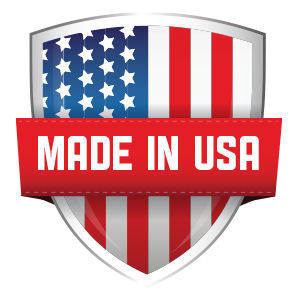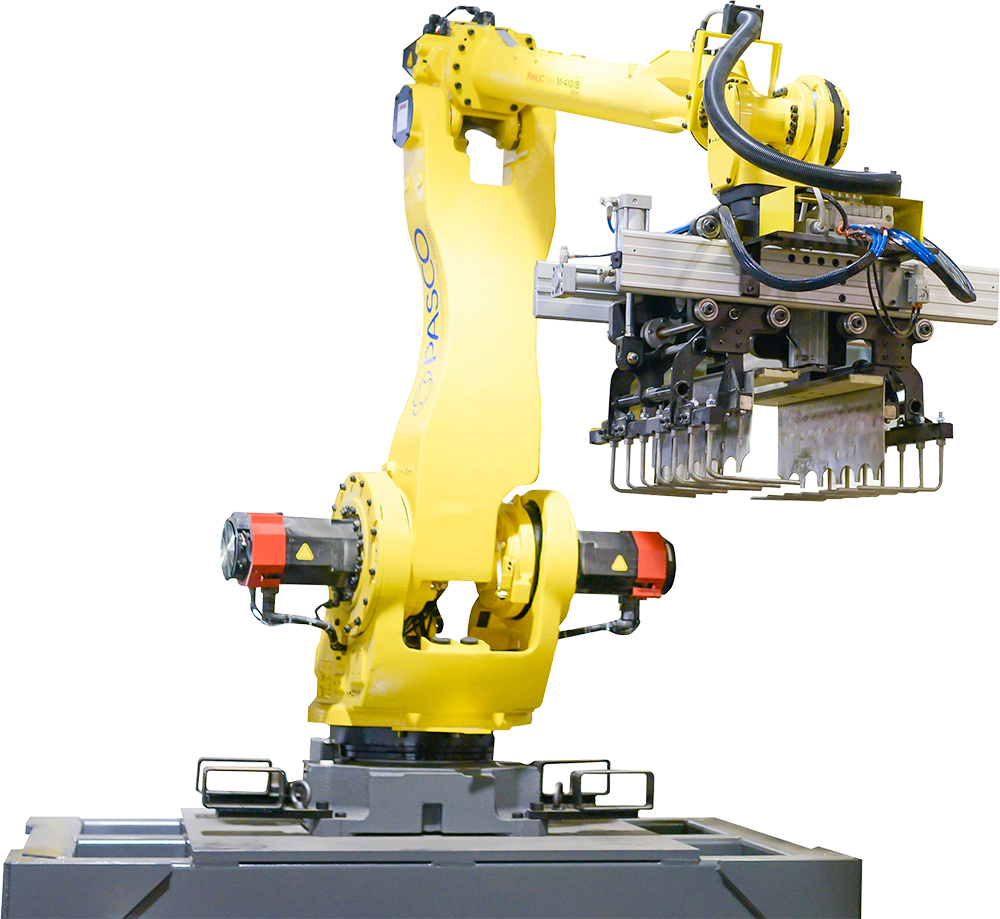U.S. manufacturing is under constant pressure to move faster, maintain quality and protect workers; demands that manual valve bag placement simply can’t keep up with anymore. Automating empty valve bag handling with robotic bag placers transforms production lines, delivering faster speeds, greater precision, and better overall efficiency.
In this quick guide to valve bag placing, we’ll walk through:
- The hidden costs and risks of manual valve bag placement
- How robotic valve bag placers deliver higher throughput, accuracy, and uptime
- Ways to measure labor savings and ROI
- Safety and ergonomic benefits for operators
- Quality improvements and waste reduction through precision placement
- Flexibility to handle different bag types and fast changeovers
- ROI calculation methods and real-world results
- PASCO’s proven expertise, in-house manufacturing, and ongoing support
- How to integrate robotic valve bag placing into your existing packaging line
With nearly 50 years of packaging-automation leadership, PASCO’s robotic valve bag placer is backed by industry-leading reliability, placing empty valve bags at rates up to 40 per minute with 99.5% accuracy.
What challenges do manual valve bag placement processes present?
In many plants, manual valve bag placement means an operator sitting at the line, sliding empty bags onto filling spouts while getting hit with clouds of cement dust or other fine particles. It’s hard, repetitive work that can slow production, increase the risk of injury and affect product consistency.
When people are tasked with the same lifting, opening, and positioning motions all day, fatigue sets in. Add in constant exposure to harsh particulate matter and the challenge of aligning every bag perfectly, and it’s clear why this method struggles to keep up with modern production demands. Solving these issues is key to increasing throughput, protecting workers, and ensuring consistent quality.
How do labor shortages and repetitive tasks impact production efficiency?
When production depends heavily on manual labor, every missed shift cuts directly into output. Even when the line is staffed, repetitive tasks wear people down, slowing cycle times and increasing the chance of mistakes or wasted product.
What safety risks are associated with manual valve bag filling?
Dust-heavy environments make manual material handling a real health risk, especially for workers breathing in fine particles all day. When the filler is chemical, abrasive, or even explosive, the danger goes up fast. Those hazards don’t just put people at risk, they lead to missed workdays and costly workers’ comp claims.
How does inconsistent bag placement affect product quality?
Even a small misalignment when placing a valve bag can cause overfills, underfills or spilled product. That means wasted material, extra rework and unhappy customers.
In high-volume production, just one bag out of place can throw off the entire filling sequence, stopping the line for cleanup and cutting into efficiency and throughput.
How do robotic valve bag placers significantly increase productivity and throughput?
Robotic valve bag placers handle the entire pick–open–place cycle at high speed, keeping production moving and bag counts up around the clock. Guided by vision systems, the end-of-arm tooling grabs, pre-opens, and positions each bag with consistent accuracy—removing the delays and stoppages that come with manual handling.What speeds and capacities can modern robotic valve bag placers achieve?
With dual-arm setups, our systems keep a steady pace of 30–40 bags per minute, splitting the work between synchronized robots. High-torque actuators and efficient motion paths keep the pick-and-place cycles fast, without putting extra wear on the equipment.
How does 24/7 operation enhance manufacturing output?
Running nonstop lets the line hit its full potential. No slowdowns from shift changes, breaks, or worker fatigue. With predictive maintenance in place, uptime stays above 99%, keeping high-volume production moving without interruptions.
What role does precision play in consistent valve bag placement?
Vision-guided end-of-arm tooling makes sure every valve bag lands squarely on the fill spout, avoiding misfeeds and torn seals. That accuracy can cut overfills by up to 50% and prevent the unplanned stoppages caused by bag misalignment, keeping packaging quality high all the way down the line.
In what ways do robotic valve bag placers reduce labor costs and dependency?
Industrial automation cuts the number of people needed for valve bag placement, freeing up staff to move into operator roles and other higher-value positions. The main labor and workforce benefits include:
- Robots take on the repetitive, physically taxing tasks, letting operators focus on skilled work
- Less dependence on temp or contract labor means lower hiring and training costs
- Fewer injuries mean fewer absences and lower workers’ comp or overtime costs
With these gains, manufacturers can shift people into roles that add more value, like improving line performance, planning maintenance, or developing new products.
How do robotic valve bag placers improve workplace safety?
Automating the picking and placing of valve bags on spouts keeps manual operators away from harmful dusts and repetitive lifting.
What hazards are eliminated by using robotic valve bag placers?
Robotic arms take over the heavy lifting, repetitive shoulder movements and awkward postures that often lead to chronic injuries. They also reduce the risk of cuts, pinches, and exposure to abrasive dust during bag prep, helping keep operators safer on the job.
How does automation reduce injury risks in hazardous environments?
With bag opening and positioning kept inside guarded cells, robotic placers remove the risk of workers coming into contact with explosive or corrosive fillers. Built-in dust extraction pulls airborne particles right at the source, protecting respiratory health while keeping production running smoothly.
What safety statistics support robotic automation benefits?
Manufacturers using robotic valve bag placers have seen injury rates drop by as much as 75%. That means fewer lost-time incidents, lower insurance costs and a stronger safety culture – one that helps keep employees on the job long term.
What makes robotic bag placers deliver unmatched consistency, accuracy and quality?
Accurate bag placement cuts waste, keeps fill volumes consistent, and ensures tight seals. By taking human error out of the process, automation delivers packaging customers can trust every time.
What custom automation solutions does PASCO provide?
PASCO designs and builds custom robotic valve bag placer cells with integrated fillers, conveyors, dust control, and palletizers—delivering turnkey automation tailored to your plant’s layout and production goals.
By partnering with our sister company, Versatech, we can automate your entire line from parts to wrapped pallets.
How can you calculate the return on investment (ROI) for robotic valve bag placers?
Calculating ROI for automated valve bag-placing systems combines labor-cost savings, throughput gains, waste reduction and maintenance expenses into a financial model.
What factors influence ROI in automated valve bagging systems?
Key ROI drivers include:
- Labor savings from cutting staffing needs and overtime
- Higher throughput, with more bags placed and filled per shift
- Less waste thanks to fewer misfeeds and torn bags
- Lower maintenance costs for parts and preventative service
- Reduced energy use compared to manual operations
Looking at these factors over a 3–5 year span, many high-volume operations see payback in under 18 months.
How does PASCO’s ROI calculator help decision-makers?
PASCO offers an interactive calculator that shows what inefficient or manual operations are really costing you. It factors in production hours, staffing and overall business costs built by our experienced engineering team. Note that these are estimations and concrete numbers can only be delivered while assessing your operation.
What are real-world ROI case studies demonstrating benefits?
One major building-products manufacturer cut three full-time positions from bagging and boosted throughput by 35%, reaching full payback in just 14 months.
In the chemical industry, another client reduced waste by 40% and reworked less than 0.2% of batches—saving over $250,000 a year.
Once you’ve measured the ROI, it’s worth taking a hard look at any potential automation partner. Their manufacturing capabilities and service support can make all the difference in how profitable your system will be.
Why choose PASCO for your robotic valve bag placer needs?
- We invented the first robotic valve bag plcer in 2006. Ever since, we have evolved designs through rigorous field testing.
- We control the lion’s share of the manufacturing process. As a true OEM, we Controls quality and lead times from steel fabrication to final assembly
- We’ve placed over 100 million bags at 99.5% accuracy. Average system uptime exceeds 98%.
- We integrate with new or existing equipment. Whether you’re supporting an existing filler or wanting to start from the ground up, there’s no challenge too big.
- We’re committed to service. We offer 24/7 support and rapid parts delivery.
How do robotic valve bag placers integrate with existing packaging lines?
Integrating a robotic valve bag placer into a packaging line requires careful coordination of conveyors, fillers and downstream palletizers. A well-designed cell preserves line balance and ensures smooth material flow.
What are the key components for automation integration?
Critical elements include:
- Syncing conveyors with robot cycle times
- Forward-and-reverse pressure controls on bag-opening heads
- Safety interlocks and light curtains to protect operators
- Communication protocols (Ethernet/IP, ProfiNET) for filler and palletizer coordination
How does preventative maintenance maximize system uptime?
Scheduled inspections of wear parts, pneumatic actuators, lubrication of bearings and calibrations prevent unplanned stoppages. We’re outfitted with a team of experienced service technicians. And when you need help, you work with the team directly involved with your system from day one.
Robotic valve bag placement takes the strain out of high-volume production. By removing manual steps, it helps manufacturers move faster, cut labor costs, and create a safer work environment. With tighter control over quality, less waste, and the flexibility to handle changing product demands, it’s a smarter way to run. PASCO’s proven robotic valve bag placer — backed by our in-house engineering team and dedicated service — delivers a ready-to-run solution that speeds up ROI and keeps operations running at their best.



